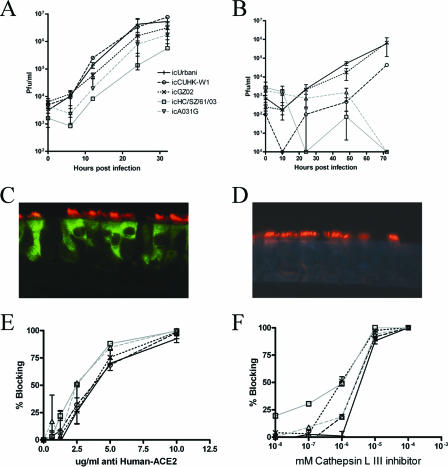FIG. 2.
In vitro growth characteristics of recombinant SARS-CoV spike glycoprotein variants and their use of ACE-2 and cathepsin L for binding and entry. (A and B) Cultures of Vero E6 cells (A) or human airway epithelium cells (B) were infected in duplicate with the S glycoprotein variants at a high MOI of 2 or >1, respectively, as described in Materials and Methods. Virus titers at different time points were determined by a plaque assay using Vero E6 cells. (C and D) HAE cell cultures infected with the icUrbani (C) or icHC/SZ/61/03 (D) isolate were stained for icSARS-CoV nucleoprotein (green) and alpha-tubulin (red) with mouse MAbs as described in Materials and Methods, with original magnifications of ×100. Staining of HAE infected with icUrbani was representative of icCUHK-W1 and icGZ02 and of HAE infected with icHC/SZ/61/03 was representative of icA031G. (E and F) To determine the role of ACE-2 and cathepsin L in binding and entry of the different S variants, Vero E6 cells were pretreated with polyclonal antibodies directed against either human ACE-2 (E) or cathepsin L inhibitor III (F) and infected with recombinant SARS-CoV spike glycoprotein variants as described in Materials and Methods. Blocking results are expressed as the mean percentages of plaque numbers in anti-human ACE2- or cathepsin L inhibitor-treated Vero E6 cells relative to untreated cell results. + with solid black line, icUrbani; ○ with dashed black line, icCUHK-W1; × with dotted black line, icGZ02; □ with solid gray line, icHC/SZ/61/03; Δ with dotted gray line, icA031G. Error bars represent standard deviations.

